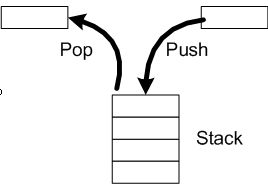The Monotone Stack Implementation in Python
- 时间:2020-09-18 17:01:02
- 分类:网络文摘
- 阅读:117 次

Stack-Operation-in-C-Programming
A stack is a first-in-last-out (FILO) data structure.
We all know that the list/array in Python is very powerful, that it can be used as a stack itself. For example, to create a stack in Python, we do this:
1 | st = [] |
st = []
Then, we can push an element to the stack using the list append() method.
1 2 3 4 5 | st.append(1) st.append(2) st.append(3) # now the stack has 3 elements [1, 2, 3] |
st.append(1) st.append(2) st.append(3) # now the stack has 3 elements [1, 2, 3]
We can check the length of the list in order to perform the stack.empty() test.
1 2 | def isEmptyStack(st): return len(st) == 0 |
def isEmptyStack(st): return len(st) == 0
The last element in the list/array will be useful, such as peeking the top of the stack:
1 2 | def peekStack(st): return st[-1] |
def peekStack(st): return st[-1]
Popping an element is even simpler with the array.pop() method – which removes the last element from the list/array and return it.. For example:
1 2 | def popStack(st): return st.pop() |
def popStack(st): return st.pop()
The Monotone Stack in Python
A Monotone stack is a stack, however, it preserves the orders of the elements in the stack from left to the right. For example, the Monotone decreasing stack looks like:
1 | st = [5, 4, 3, 2, 1] |
st = [5, 4, 3, 2, 1]
Now, if we now push another element, e.g. 3, to the stack. It will pop out elements that are smaller than 3 before 3 is pushed to the stack.
1 | st = [5, 4, 3, 3] # 2 and 1 will be removed |
st = [5, 4, 3, 3] # 2 and 1 will be removed
At anytime, the monotone stack will keep the elements in the stack in either increasing or decreasing order (monotone sequence). The Monotone stack is handy as it tells us the next larger-or-equal element. For example, in the above case, we know the next larger-or-equal number is 3.
1 2 3 4 | def pushMontoStack(st, ele): while len(st) > 0 and st[-1] < ele: st.pop() st.push(ele) |
def pushMontoStack(st, ele):
while len(st) > 0 and st[-1] < ele:
st.pop()
st.push(ele)Similarly, we can use the same data-structure i.e. array/list in Python to implement a montotone Queue.
–EOF (The Ultimate Computing & Technology Blog) —
推荐阅读:常用的数学英语单词 年历怎么制作 0为什么不能作除数 小学作文元宵节 树下的时光 我的嘴怎么也张不开_关于教师节的小学生作文400字 爱是一场慈悲的修行 国庆游动物园作文 爱着你的爱,疼着你的疼 长征.丰碑
- 评论列表
-
- 添加评论